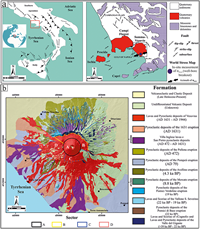Assessing future vent opening locations at the Somma-Vesuvio volcanic complex: 1. A new information geodatabase with uncertainty characterizations
Tadini A., M. Bisson, A. Neri, R. Cioni, A. Bevilacqua, W. P. Aspinall (2017).
Journal of Geophysical Research: Solid Earth, First Published: 17 June 2017, doi: 10.1002/2016JB013858.
Abstract
This study presents new and revised data sets about the spatial distribution of past volcanic vents, eruptive fissures, and regional/local structures of the Somma-Vesuvio volcanic system (Italy). The innovative features of the study are the identification and quantification of important sources of uncertainty affecting interpretations of the data sets. In this regard, the spatial uncertainty of each feature is modeled by an uncertainty area, i.e., a geometric element typically represented by a polygon drawn around points or lines. The new data sets have been assembled as an updatable geodatabase that integrates and complements existing databases for Somma-Vesuvio. The data are organized into 4 data sets and stored as 11 feature classes (points and lines for feature locations and polygons for the associated uncertainty areas), totaling more than 1700 elements. More specifically, volcanic vent and eruptive fissure elements are subdivided into feature classes according to their associated eruptive styles: (i) Plinian and sub-Plinian eruptions (i.e., large- or medium-scale explosive activity); (ii) violent Strombolian and continuous ash emission eruptions (i.e., small-scale explosive activity); and (iii) effusive eruptions (including eruptions from both parasitic vents and eruptive fissures). Regional and local structures (i.e., deep faults) are represented as linear feature classes. To support interpretation of the eruption data, additional data sets are provided for Somma-Vesuvio geological units and caldera morphological features. In the companion paper, the data presented here, and the associated uncertainties, are used to develop a first vent opening probability map for the Somma-Vesuvio caldera, with specific attention focused on large or medium explosive events.
http://onlinelibrary.wiley.com/doi/10.1002/2016JB013858/full


